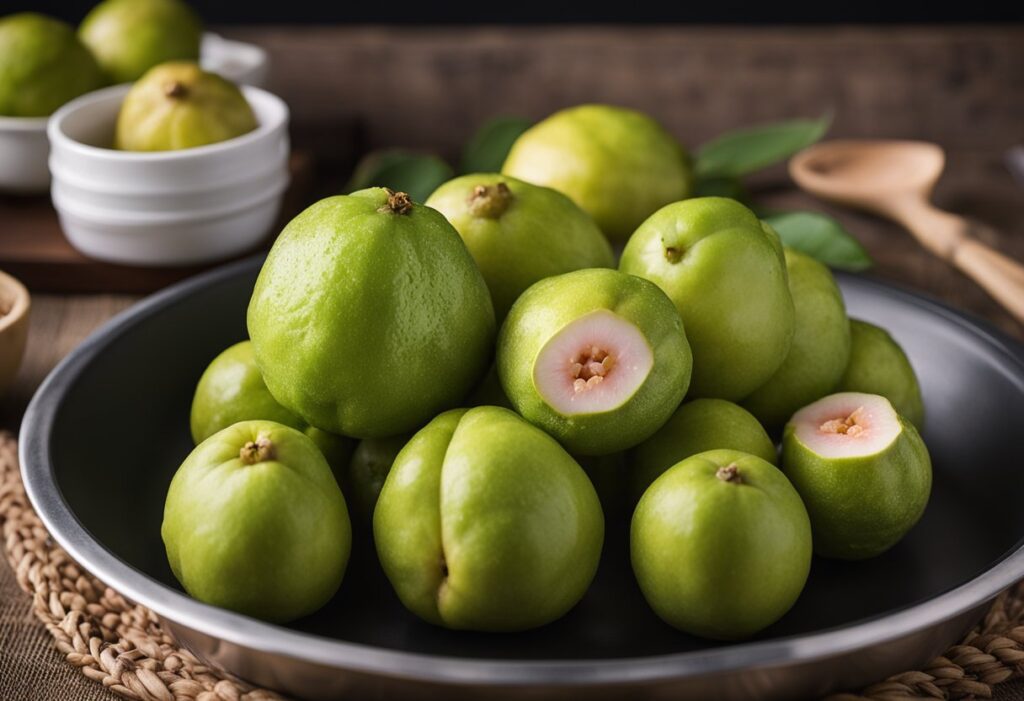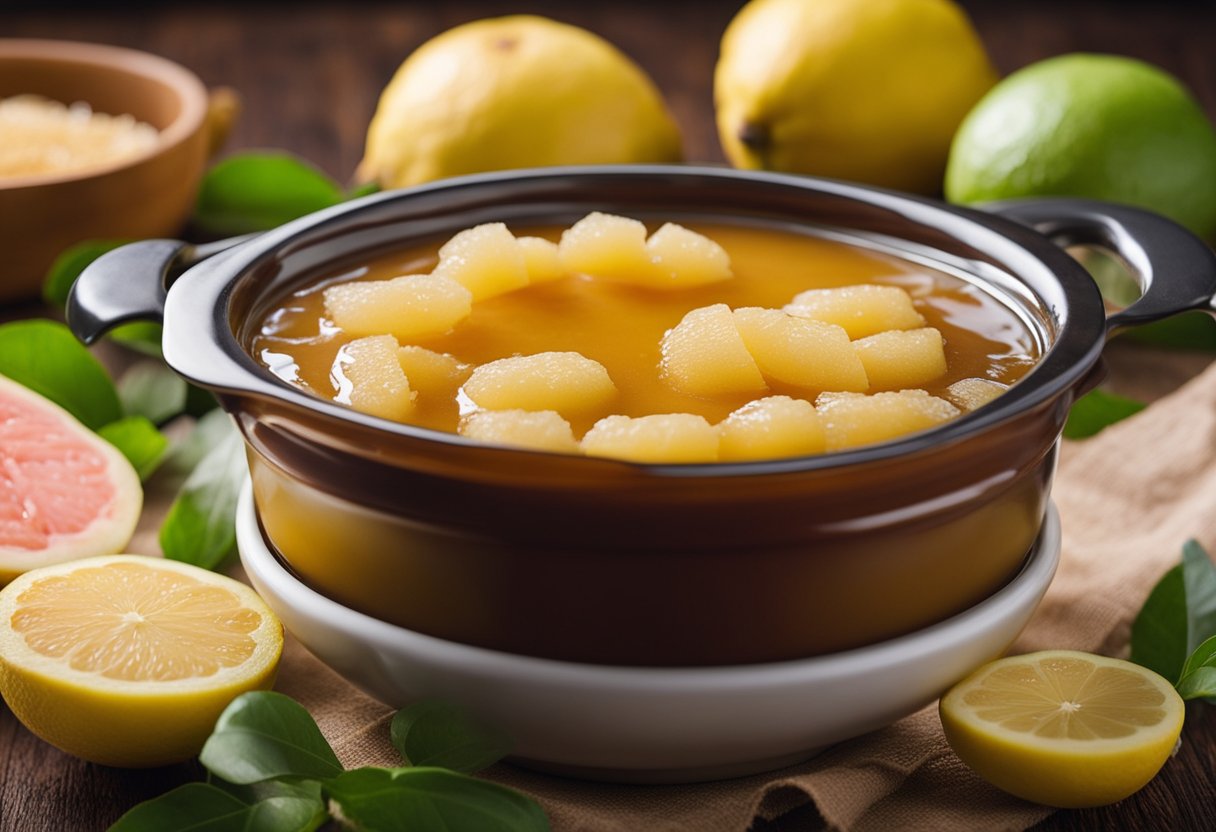Guava paste is a sweet and delicious treat that is enjoyed in many Latin American countries. It is made from guava fruit, which is cooked down with sugar and spices until it forms a thick, spreadable paste. Guava paste can be used in a variety of ways, from spreading it on toast or crackers to using it as a filling for pastries and cakes.
Table of Contents

Making guava paste at home is a great way to enjoy this tasty treat and experiment with different flavors and spices. The process is relatively simple, requiring just a few ingredients and some patience as the fruit cooks down. With a little practice, anyone can make their own guava paste and enjoy the sweet, tropical flavor of this delicious fruit. In this article, we will provide a step-by-step guide to making guava paste at home, along with tips and tricks for getting the best results.
Understanding Guava Paste
History of Guava Paste
Guava paste, also known as guava cheese or goiabada, is a traditional Latin American dessert that originated in Brazil. It is made by cooking guava pulp with sugar until it thickens into a paste-like consistency. The paste is then poured into molds and left to set before being sliced into squares or rectangles. The sweet and tangy flavor of guava paste has made it a popular ingredient in many Latin American desserts, such as empanadas, pastries, and cakes.
Culinary Uses
Guava paste is a versatile ingredient that can be used in both sweet and savory dishes. In addition to being a popular dessert filling, it can also be used as a glaze for meats, such as ham or pork. It can also be spread on toast, crackers, or cheese for a sweet and savory snack. Guava paste can also be melted down and used as a sauce for ice cream or other desserts.
Health Benefits
Guava paste is a good source of vitamin C, fiber, and antioxidants. Vitamin C is an essential nutrient that helps boost the immune system and promote healthy skin and hair. Fiber is important for digestive health and can help lower cholesterol levels. Antioxidants help protect the body against damage from free radicals, which can contribute to chronic diseases such as cancer and heart disease.
Overall, guava paste is a delicious and nutritious ingredient that can add flavor and texture to a variety of dishes. Its sweet and tangy flavor, along with its versatility, has made it a staple in Latin American cuisine and beyond.
Ingredients Required
To make guava paste, you will need the following ingredients:
- 2 lbs guava fruit (ripe and soft)
- 2 cups granulated sugar
- 1/2 cup water
- 1 cinnamon stick
- 1/4 tsp ground nutmeg
- 1/4 tsp ground cloves
- 1/4 tsp salt
The guava fruit should be ripe and soft to ensure maximum sweetness and flavor. It’s important to use granulated sugar for this recipe, as it will dissolve easily and help create a smooth texture.
The cinnamon stick, nutmeg, and cloves add warm, spicy notes to the guava paste. The salt helps balance out the sweetness and enhances the overall flavor.
In addition to these ingredients, you will also need a large pot, a blender or food processor, and a square baking dish to set the guava paste in.
Equipment Needed
To make guava paste, there are a few essential pieces of equipment that will make the process much easier. Here are the items you will need:
- Large pot: You will need a large pot to cook the guava paste mixture. A pot that holds at least 6 quarts is recommended.
- Blender or food processor: To puree the guava fruit, you will need either a blender or food processor. A blender is preferable as it can handle larger quantities.
- Fine mesh strainer: After pureeing the guava, you will need to strain it to remove any seeds or pulp. A fine mesh strainer works best for this.
- Wooden spoon: A wooden spoon is ideal for stirring the guava paste mixture as it cooks. It won’t scratch the pot and won’t react with the acidic fruit.
- Candy thermometer: To ensure that the guava paste reaches the correct consistency, you will need a candy thermometer. The mixture should reach 220°F (104°C) before it is done.
- Parchment paper: Once the guava paste is cooked and cooled, it will need to be wrapped in parchment paper. This will keep it from sticking to itself and make it easier to handle.
Having these pieces of equipment on hand will make the process of making guava paste much smoother and more enjoyable.
Preparation Steps
Cleaning the Guavas
Before starting the recipe, it is important to wash the guavas thoroughly with water to remove any dirt or debris. Once cleaned, cut off the ends and slice the guavas into small pieces. Remove the seeds from the center of the fruit and discard them.
Cooking the Fruit
In a saucepan, add the sliced guavas along with water and sugar. Cook the mixture over medium heat, stirring occasionally, until the guavas become soft and the water has evaporated. This should take around 20-25 minutes.
Blending and Straining
Once the guavas have cooked, transfer the mixture to a blender and blend until smooth. If the mixture is too thick, add a little water to thin it out. Once blended, strain the mixture through a fine mesh sieve to remove any remaining seeds or pulp.
The guava paste is now ready to be used in various recipes such as pastries, cakes, and desserts. Store the paste in an airtight container in the refrigerator for up to two weeks.
Cooking Process
Sugar Syrup Creation
To start the guava paste recipe, a sugar syrup must be created. In a saucepan, combine two cups of granulated sugar and one cup of water. Heat the mixture over medium-high heat, stirring occasionally until the sugar has dissolved. Once the sugar has dissolved, reduce the heat to medium-low and let the mixture simmer for 10-15 minutes until it thickens and becomes syrupy.
Combining Ingredients
While the sugar syrup is simmering, prepare the guavas. Wash and peel six medium-sized guavas and remove the seeds. Cut the guavas into small pieces and add them to the sugar syrup. Stir the mixture well and continue to cook over medium-low heat for 30-40 minutes until the guavas are soft and the mixture has thickened.
Setting the Paste
Once the guava mixture has thickened, remove it from the heat and let it cool for a few minutes. Transfer the mixture to a blender or food processor and blend until it becomes a smooth paste. Pour the paste into a greased baking dish or mold and let it cool at room temperature for at least an hour. Once it has cooled, cover the dish or mold with plastic wrap and refrigerate for several hours or overnight until the paste has set.
Overall, the cooking process for guava paste is relatively simple and straightforward. By following these steps, anyone can create a delicious and authentic guava paste that can be enjoyed on its own or used in a variety of recipes.
Storage and Preservation
Guava paste can be stored for a long time if properly preserved. The following are some tips to help extend the shelf life of your guava paste:
- Store the guava paste in an airtight container to prevent moisture from getting in. This will help keep the paste fresh and prevent mold growth.
- Keep the guava paste in a cool, dry place away from direct sunlight. Exposure to heat and light can cause the paste to spoil quickly.
- If you have a large quantity of guava paste, consider freezing it. Guava paste can be frozen for up to six months. To freeze, wrap the paste tightly in plastic wrap or aluminum foil and place it in an airtight container or freezer bag.
- To thaw frozen guava paste, transfer it to the refrigerator and let it thaw slowly overnight. Avoid thawing the paste at room temperature or in the microwave, as this can cause the paste to become too soft and lose its texture.
By following these simple storage and preservation tips, you can enjoy your homemade guava paste for months to come.
Serving Suggestions
Pairing with Cheeses
Guava paste is a perfect accompaniment to a cheese board. Its sweet and tangy flavor pairs well with a variety of cheeses, such as sharp cheddar, creamy brie, and salty feta. To serve, simply slice the guava paste into thin wedges and arrange them alongside the cheese. The combination of flavors and textures is sure to impress your guests.
Dessert Applications
Guava paste is a versatile ingredient that can be used in a variety of desserts. One popular option is to use it as a filling for empanadas or turnovers. Simply spoon a dollop of guava paste onto a circle of pastry dough, fold it over, and bake until golden brown. Another option is to serve guava paste alongside vanilla ice cream for a simple yet delicious dessert. For a more sophisticated dessert, try topping a slice of pound cake with guava paste and a dollop of whipped cream.
Whether you’re serving it with cheese or using it in a dessert, guava paste is a delicious and unique ingredient that adds a touch of tropical flavor to any dish.
Variations and Substitutes
There are several variations and substitutes that can be used when making guava paste. Here are a few options to consider:
- Sugar substitutes: If you are looking for a healthier alternative to sugar, you can use honey, agave nectar, or maple syrup instead. Keep in mind that these substitutes may alter the taste and texture of the guava paste.
- Spices: To add some extra flavor to your guava paste, you can try adding cinnamon, nutmeg, or ginger. These spices pair well with the sweetness of the guava.
- Fruit combinations: You can experiment with different fruit combinations to create unique flavors. For example, you can mix guava with mango, pineapple, or passionfruit. This will give your guava paste a tropical twist.
- Texture: If you prefer a smoother texture, you can strain the guava pulp before cooking it. On the other hand, if you like a chunkier texture, you can leave some of the pulp in.
- Cooking method: While most guava paste recipes call for cooking the pulp on the stove, you can also try baking it in the oven. This will give your guava paste a slightly different flavor and texture.
Overall, there are many ways to customize your guava paste recipe to suit your taste preferences. Don’t be afraid to experiment with different ingredients and techniques to find the perfect combination.
Troubleshooting Common Issues
Guava paste is a delicious treat that can be enjoyed on its own or used as an ingredient in various recipes. However, there are a few common issues that can arise when making guava paste. Here are some tips to troubleshoot these issues:
Problem: Guava paste is too hard
If your guava paste turns out too hard, it may be due to overcooking. The longer you cook the paste, the harder it will become. To avoid this issue, make sure to cook the guava paste on low heat and stir it frequently to prevent burning. You can also add a little bit of water or fruit juice to the mixture to help soften it up.
Problem: Guava paste is too soft
If your guava paste turns out too soft, it may be due to undercooking. The paste needs to be cooked until it is thick and sticky. If it is too soft, it may not set properly and will be difficult to cut into pieces. To avoid this issue, make sure to cook the guava paste on low heat for a sufficient amount of time. You can also add a little bit of sugar or pectin to the mixture to help it set.
Problem: Guava paste has a grainy texture
If your guava paste has a grainy texture, it may be due to the presence of seeds or pulp. To avoid this issue, make sure to strain the guava pulp before cooking it. You can also use a blender or food processor to puree the pulp and remove any seeds or pulp. Additionally, you can add a little bit of lemon juice or vinegar to the mixture to help break down the fibers and create a smoother texture.
By following these tips, you can troubleshoot common issues that may arise when making guava paste and ensure that your final product is delicious and satisfying.

